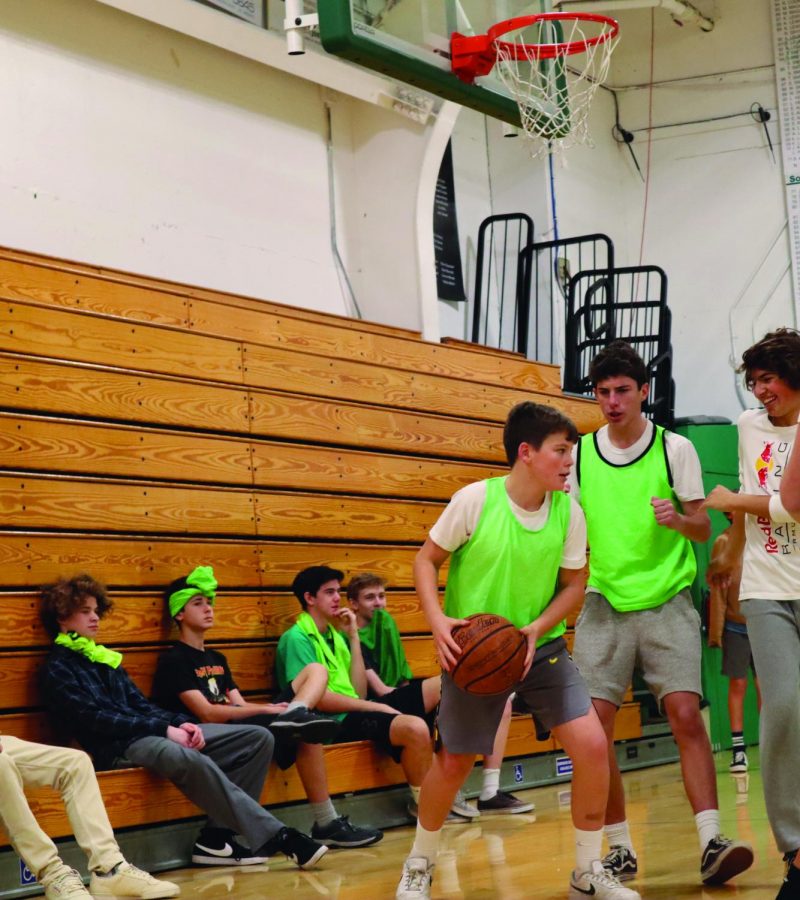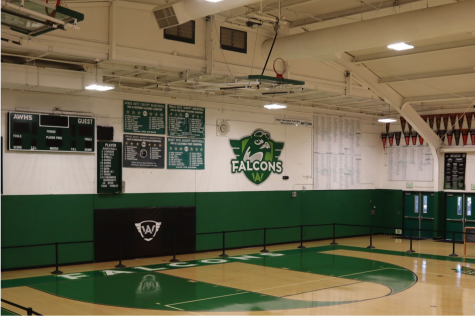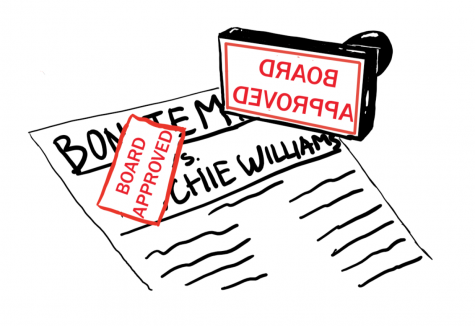Physical education should not be a high school requirement
Some students play basketball in PE, while others sit by and watch, showing both sides of the enthusiasm spectrum
Many students detest physical education (PE) class, as it breeds athletic and social supremacism. For others, it gives them a great opportunity to blow off some steam after a long day of remaining relatively stationary. Regardless, high school students should not be required to participate in PE as it does not benefit their health as its proponents intended.
The purpose of PE is to encourage children to move around and to apply their knowledge to develop a healthier lifestyle. PE is also designed to work against obesity, as over 340 million children and teenagers (ages 5-19) were deemed overweight or obese in 2016 by the World Health Organization’s standards. Although this national issue continues to worsen, PE may not be the best solution.
A 2015 study on Texas’ Fitness Now program found physical education to be ineffective and having no effect on children’s’ body mass index (BMI). In gym class, children are typically only active 3 days a week for forty-five minutes each day. This will not significantly lower BMI, especially if some students choose to participate minimally.
Instead of focusing on superficial numbers, like BMI and how long it takes to run a lap, PE should teach children ways to incorporate health into their own lives. This will prepare them for their future more than a game of dodgeball will.
PE also makes those who do not play sports feel self-conscious and uninterested. Students give up if they need to run a lap around the track in an amount of time that they know they cannot achieve. It creates a sense of hierarchy that creates the impression that athletic children are superior to the unathletic.
Children who play sports often dominate the scrimmages and activities, leaving the rest of the children feeling uneasy. They often rarely pass the ball to the “awkward” or “shy” kids, which deprives these students of productive activity and results in a negative environment.
It is because of this negative environment that PE programs across the nation have poor attendance. According to a 2016 study by the National Physical Activity Plan, around one half of all US high school students do not attend PE classes daily. In schools that require PE for all four years of high school, attendance decreases more and more every year from students ditching.
For children in kindergarten through middle school, on the other hand, physical education is necessary. Children must become familiar with movement at a young age so that they stay active throughout their lives. However, in high school, students are old enough to make their own decisions.
High school athletes that have participated in sports and have received physical education through middle school do not need to toss a frisbee for an hour. If they were able to just attend their sports or dance practice instead of taking PE, it would have a greater benefit on their athleticism. If students do not play a sport in high school, they clearly are not interested in sports and will likely not participate in PE class.
High school students deserve the freedom to choose whether or not they wish to participate in PE. Physical education creates an unhealthy environment for many students, and should not be required.

Samantha is a senior in her third year in journalism. She loves little old bookstores, the smell of almond extract, and rewatching Stranger Things. When...









Jack Yesensky • Mar 14, 2025 at 3:07 PM
hello
Keaton Pamer • Mar 12, 2025 at 10:31 AM
Hi
Keaton • Mar 12, 2025 at 10:31 AM
hello
Lukas Smith • Mar 11, 2025 at 5:40 PM
Hello
fred • Feb 21, 2025 at 10:45 AM
gyattttttttttt
Valentina • Feb 4, 2025 at 12:57 PM
fr gym should not be required i legit hurt my knee which is now in a brace because of dodgeball!!! like goodbye gym
ireijgir • Feb 4, 2025 at 12:33 PM
why is there P.E?
Trinity mika • Feb 4, 2025 at 8:06 AM
I think that PE is boring and risky; you can break your bones
Johnathan leckman • Feb 4, 2025 at 12:19 PM
trinity why are you on here?
Valentina • Feb 5, 2025 at 12:58 PM
fr
Johnathan leckman • Feb 4, 2025 at 12:56 PM
Trinity how are you on it with school gmail
Johnathan leckman • Feb 4, 2025 at 1:06 PM
Trinity help me get on it pls.
noob1 • Feb 4, 2025 at 1:36 PM
its not boring if u swish a 3 pointer in backetball
caius dunston • Feb 18, 2025 at 5:16 PM
fr
Xander • Jan 15, 2025 at 10:19 AM
ya but what about other schools like middle school or elimentry
BAST • Dec 6, 2024 at 9:23 AM
I think PE is mandatory
Xander • Jan 15, 2025 at 10:21 AM
No because there isn’t enough verity and sports can be like a door for bullying because they aren’t good at that sport and they can also get to competitive
whitley arriaga • Nov 14, 2024 at 9:03 AM
Children who play sports often dominate the scrimmages and activities, leaving the rest of the children feeling uneasy. They often rarely pass the ball to the “awkward” or “shy” kids, which deprives these students of productive activity and results in a negative environment.
This is not true because there are multiple kids that just pass it to there frineds and you have to be bealive me. BECAUSE I AM A KID!!!!!!
logan • Dec 5, 2024 at 9:35 AM
that’s not true because the good kids at sports don’t like to pass to the shy kid because they don’t want to sell the game.
logan • Dec 6, 2024 at 9:25 AM
I don’t believe you with that spelling
Wyatt • Feb 4, 2025 at 12:44 PM
I know from experience when I was younger this is so true.
Noah Spitkovsky • Feb 22, 2024 at 9:07 AM
PE is good for kids’ mental health.
Shayaan Doodekula • Apr 1, 2024 at 6:44 AM
How?
Charlie • Jul 17, 2024 at 11:40 AM
Ok, and why would PE make kids feel self conscious? Because some kids can’t run as fast as others? Some kids aren’t as active as others, because they’re not in good shape. Childhood obesity rates has been increasing rapidly. PE is not for a kid to develop a six pack, it’s for kids to move their bodies in different ways. PE helps kids learn new sports. And if your kid is self conscious about not being as fit as others they need to do something about it or own it.
logan • Dec 5, 2024 at 9:36 AM
slay queen
maddison • Feb 3, 2025 at 10:29 AM
no its not I have mental health and it doesn’t help
nyomi • Feb 22, 2024 at 7:06 AM
I wouldn’t say I like this website it didn’t help me at all I was doing school work and I got a F on my grade so I do not recommend this website
shirah • Feb 22, 2024 at 7:04 AM
P.E is a break that kids need its like reses when your not in elementary and it gives Kids a chance to worck out (lord knows they dont work out at home its always Phone tv, Phone tv).and itslike a brain break its a Fun part of a kids day when they play dodg-ball, soccer or basketball.
Wyatt • Feb 4, 2025 at 12:48 PM
yes
Joe • Feb 22, 2024 at 6:55 AM
Is this a bias?????
Addison • Nov 13, 2023 at 10:20 AM
PE should have a alot to do with school
Addison • Nov 13, 2023 at 10:13 AM
PE is good for people to get there energy out and get to play with there friends.
Kendall • Nov 10, 2023 at 5:51 AM
Math shouldn’t be required in high school. It makes students self-conscious. They give up when they can’t answer questions that require computation correctly.
English shouldn’t be required in high school. It makes students self-conscious. They give up when they can read passages and understand them.
See how dumb that sounds? The point is, life is full of things that make us self-conscious or take us out of our comfort zone. Meeting those things head-on and conquering them is how we grow.
Can PE be done differently? Yes. By all means. Any teacher education program for physical educators that is worth anything has been focusing on making positive changes for years. Not all students are competitive, activities should reflect that and provide alternatives for all. Overall fitness and healthy habits are a point of emphasis, each lesson should demonstrate some way to apply concepts to everyday life. Fitness testing should be a means of gathering data and looking for improvement rather than focusing so much on hard numbers that reflect success or failure. Although the goal should be finding a way to reach a healthy fitness level in the tested areas eventually. They are tied to risk factors for lifestyle diseases.
One can see those things happening in a well taught physical education class. The problem is schools often don’t give PE teachers the basic tools and resources they need to effectively teach their classes. Dumping kids into a class with double and triple the student to teacher ratio that classroom teachers have is much of the problem. It would be considered unacceptable in other subjects, so why isn’t it for PE?
I put forth the counter argument that we need to draw a line in the sand and keep requirements as they are or strengthen them. The main push-back against PE is ultimately coming from parents. We have an obesity rate approaching 40% in this country. It is obvious they don’t find basic physical activity, exercise, and healthy eating habits to be important. Students pick up on it and see it as an opportunity to leverage a way to get out of something they don’t like. Further, we can see that kind of sentiment brewing against science and literature with some of ignorant social and political pushes as of late. If we get rid of PE, what is to stop science form being next? What is to stop book banning from becoming commonplace rather than something we get upset about?
We are much better off making positive changes in physical education and giving our teacher what they need in our schools to teach it correctly.
Kay • Jan 4, 2024 at 2:39 AM
Science is academic. Math is academic. English is academic. PE is not really an academic subject. PE is athletics based. Education is a whole needs to be more about learning and what not. But besides, this idea about PE being good and encouraging physical activity is a lie. Many student walk to and from school. Walk and rush half of the school day. In the workforce we don’t stop what we’re doing to workout. We eat. Unless you’re a physical trainer or an athlete. People make a choice before or after work to get exercise.
Unlike with actual academic subjects, there’s no potential future benefit. You’re not going to college to take a PE class. The only people who benefit from PE are athletes who like sports or athletic activity. Coaches are always fishing for talent.
At some point in the future a kid may use algebra or calculus. Chances are low, but there’s still a chance. That chance decreases even more when it comes to anything in PE. The shelf life anything learned in PE is pretty immediate. Don’t know when I’ll need to ring a bell, play football or whatever else. I played soccer for fun as a kid. I’m not a professional athlete though.
. • Aug 5, 2024 at 10:48 AM
First off, Physical Education IS academic. Whereas the other subjects you mentioned, I could argue, benefit people when it comes to simply consuming information, rather than it being of any PRACTICAL use in the everyday lives of adults. Many of the subjects and life skills introduced to a kid within Physical Education are used in everyday life. Through physical activity, students are taught how to share; how to take turns; how to persevere through difficult times; how to collaborate with others who have physical and/or social differences; how to be more inclusive; how to strengthen their weaknesses and focus on their strengths, and more. Many of the topics that come up in high school ELA or Math courses however, are NOT used in everyday life, unless that child decides to pursue a career in a specialty, such as Engineering, Internal Medicine, or Law. .
When it comes to Physical Education, there are a variety of ways one can deliver instruction. Instruction can be movement-based (movement education), fitness-based (weight-lifting or fitness conditioning), sports-based (sports education). YOUR opinion is that the sports education method is non-academic as you implied in your comment. That is far from true. Within the sports education model, students learn personal and social responsibility when it comes to working with others. Students also learn the necessary fine motor and gross motor skills necessary to accomplish a goal-oriented activity (sport). They learn the necessary spatial awareness to keep others as well as themselves, safe. And, they can apply ALL of these skills, in everyday life.
You may argue that many students may not pursue sports when they get older, whether it be in college, at the professional level, or even during their leisure time. And while that is definitely true for many, many of the skills taught within a sports education model can be applied to one’s everyday life. Examples include working on a team-oriented task in the corporate world where you may have to work with others who subscribe to different lifestyles, opinions, or ways of doing things. Having the experience of working with others with differences in a P.E. setting help train oneself to find the things they have in common
bretton hearn varn • Nov 9, 2023 at 10:04 AM
This type of article is dangerous to the health of all humans. It suggests that exercise is not imperative to one’s overall health physically and mentally. Either kids build a foundation of health and fitness early or they will struggle trying to lay the foundation in their later years which I have personal experience.
Maybe we can call it something different and instead of asking for athletic feet via time trials, we can encourage movement of any form. Even walking is better than nothing.
Kay • Jan 4, 2024 at 2:20 AM
Kids naturally play for recreational purposes. PE has never encouraged anyone to build habits. How is it healthy to have lunch and then heavy physical activity? Other than that, the only time you want to become physical fit, no matter what stage of life you’re in, that’s a personal choice. PE doesn’t encourage that. School definitely doesn’t. You’re sedentary most of the day.
Sofia • Apr 20, 2024 at 12:26 AM
I’ve used skills learned in PE all the time. I’m a current university student in a STEM major, and I daresay I use the information I got in my PE class more than I use Algebra 2. And I’m a STEM major! I use algebra and calculus every day!
Our PE classes were not concentrated solely on sports or drills. In my first highschool PE class, I learned how to navigate a weight room, a very valuable skill now that I’m more dependent upon a gym to workout as an adult. I took an online gym class focused on establishing everyday activity in our lives, and I have maintained the habits I formed in that class years later. The only class that wasn’t directly relevant to me was an absolutely epic Challenges and Adventures course that I chose to take.
There’s enough time in the day for working on one’s future as a teen. My physical education requirements did not limit the number of science and math courses I took, and I was more than prepared for college. But not everything in life needs to be for your career anyway.
That’s not even counting the essential social skills and cooperation that PE teaches. That’s far more valuable to future job opportunities than an extra credit of AP physics or whatnot. Especially in that C&A course I took, I got lots of practice interacting and utilizing teamwork effectively, something that other disciplines can’t teach quite as well as PE can. I made lasting friendships in all those PE classes as well, something less quantifiable as an academic boon, but still extremely valuable nonetheless.
I suppose if your PE is drill sergeant enforced vigorous exercise straight after lunch, then it might be less valuable. But not all PE is like that. I had PE that focused on teamwork and health literacy, and it was very successful at both teaching me crucial collaboration and social skills, and at changing my couch-potato middle school self to prioritize and incorporate activity into my day into adulthood.
PE has very successfully encouraged me to build habits, that I still maintain to this day. Our PE classes gave us the tools and instruction and guidance to make that choice to be physically active, which isn’t immediately obvious to all 14 year olds. Many people can make a more informed decision to be active after being exposed to the variety of ways to exercise, and explicitly taught and encouraged to incorporate activities one likes into their lives. The number of people I’ve argued with who think only running/weightlifting/sports is exercise makes me think that encouraging pursuit of varied forms of activity is not something obvious and needs to continue to be taught.
Ideally there’s some choice in highschool PE classes though, to encourage kids to pursue what they are interested in as a future lifelong activity, rather than being forced through endless basketball games if they know by now that they hate basketball. It shouldn’t be a repeat of middle school PE, it should recognize the growing autonomy and independence of highschoolers, and focus on teaching them to incorporate activities into their lives outside of school.
Abigayle. • Sep 7, 2023 at 3:41 PM
I am reading this just to detest my P.E. Class, they make us do reps for over 25 minutes with no breaks in between, we don’t even have a water fountain. We also start by running laps. I just got to my school and already want the year to end. KHS quit this.
linda • Apr 4, 2023 at 12:31 PM
i’m doing a debate on wether or not p.e. should be required for all students and this was like pretty helpful so yassssss
Kailey Hernaez • Feb 5, 2025 at 3:52 PM
Copy and paste exist
Kailey Hernaez • Feb 5, 2025 at 3:53 PM
I’m also doing a debate and I don’t know what to do because of the comment section
Luther • Feb 14, 2023 at 7:26 AM
How are ther 340million children that are obese in america if theres only 330 million people in the usa
Drew • Mar 29, 2023 at 10:57 AM
Its all of the kids in the world, not just the US.
mark • Mar 30, 2023 at 10:24 AM
that is true
logan • Dec 6, 2024 at 9:19 AM
nu uh
linda • Apr 4, 2023 at 12:41 PM
but like how are there so many obese people if they’re not all in america? i thought we were the obese ones with our mcd’s lmao
Hogan • Dec 6, 2024 at 9:16 AM
your mom needs exercise
Johnathan leckman • Feb 4, 2025 at 12:25 PM
It’s the world.